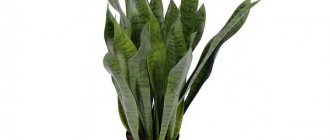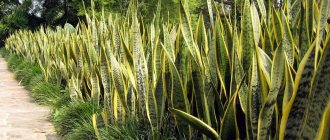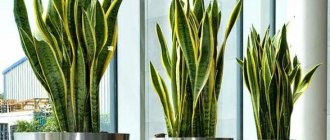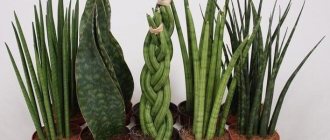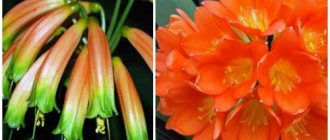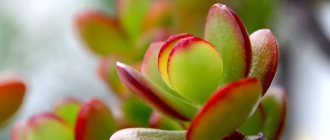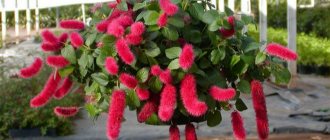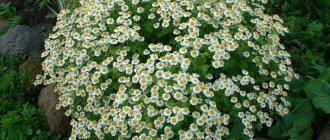Sansevieria trifasciata is without a doubt one of the most aesthetically pleasing and low-maintenance indoor plants. In recent years, Sansevieria has increasingly appeared in the interiors of not only government institutions, offices and cafes, but also in the interiors of apartments.
There are a huge number of Sansevieria varieties, and even more names. The indoor flower is popularly called “mother-in-law’s tongue”, “pike tail”, and the name Sansevieria itself can have such a variant as “Sansevieria”.
In this article we will look at:
- Caring for sansevieria (what conditions are needed, how to water it, do you need to feed it?)
- Types of Sansevieria.
- Reproduction of Sansevieria (how to plant and how to transplant the Pike Tail flower? How to transplant Sansevieria into another pot?)
- How Sansevieria blooms. (does it bloom at all? Types, timing, photos and names)
Description of the plant
The herbaceous flower is not an annual and not demanding, which is why it is popular. The stemless evergreen sansevieria trifasciata of the Asparagus family is found “in the wild” in the tropics and subtropics. Most often this is India and South Florida, but they have learned to cultivate and successfully propagate mother-in-law’s language in our area.
Snakeskin (in this case, the name, surprisingly, comes from the color, and not from the shape) is included in the genus Agave, which, meanwhile, contains more than 60 species.
If you thought that mother-in-law’s tongue is characterized by a lot of attention and constant care, then you don’t have to worry - everything will be fine with the Sansevieria flower, even skipping watering or flooding it with water, and if you want to quickly plant it in other pots, then vegetative care will help propagation by leaf.
The Sansevieria plant is a succulent (a plant that stores water in its leaves), which explains its resistance to heat and drought. It is closely related to dracaena and yucca. It grows in rosettes of leaves that extend immediately from the rhizome.
The leaves are mostly dark or light green in color. It, in turn, is diluted with white or yellowish stripes, specks or spots that look like scales. The leaf shape varies from oval to xiphoid.
They grow vertically, but not as a rule. They can grow in different directions, grow in a spiral or parallel to the ground, but this is typical only for certain species.
The growth cone of the leaf is a sharp point; under no circumstances should it be broken off. If you have ever observed such a process in vansevieria, you know that after the tip is broken off, it dries out and turns yellow. This significantly impairs cell growth and the growth rate of the succulent itself, respectively.
Sansevieria often grows very quickly and the bush puts out new leaves every month, which can be replanted in a couple of days/weeks. But there are also long-growing species that produce 2-3 leaves per year.
Mostly people grow the following species:
- Sansevieria laurenti.
- Sansevieria three-lane.
- Pinguecula.
- Hunny.
- Cylindrical.
- Trifasciata.
Signs and superstitions
There are many signs associated with keeping a pike tail at home, some of which make people give up this flower.
There are also such superstitions and signs associated with the pike tail:
- when he appears in the house, scandals subside, swearing and quarrels are extinguished
- the plant will turn away owners who are envious and have a negative attitude towards the owners of guests
- if you put a flower at work, next to you, then your colleagues will not be able to slander you and spread gossip
- if the plant has bloomed, it’s time for new beginnings, it’s time to start a new project, it will be successful, and there will be a favorable environment and peace in the house
Types, varieties of characteristics of the Sansevieria flower
Before we move on to the topic of proper care at home, let's look at the varieties of Sansevieria. As mentioned above, there are a huge number of species, and if we consider absolutely everything and their relatives, it would take quite a long time, therefore, we will discuss only the most relevant types of Sansevieria.
Sansevieria Moonshine
Sansevieria Moonshine (from English - moonlight or silver moon). Indeed, the flower is incredibly similar to the moon, almost white and cold. The leaves of the plant are oval and grow in different directions in rosettes.
This variety of sansevieria loves light, but now it dies from direct sunlight. They leave burns on the leaves, especially if after watering drops of water remain on the leaves and the sun gradually burns them out.
This requires moderate watering 1-3 times a week; if water accumulates in the pot’s base, then you definitely need to water it. The plant is more resistant to temperatures than some other species, but can withstand no more than 35 and no less than 15 degrees for long periods.
It is interesting that in case of violations of conditions or diseases that we may not suspect, the flower will immediately report, starting to lose its characteristic color.
The leaves are very dense, up to 5-6 cm wide, reaching a height of no more than 30-35 cm. They fit perfectly on the kitchen window and on the shelves of the home interior.
Sansevieria Hyacinth sansevieria sansevieria hyacinthoides
The houseplant mother-in-law's tongue (Sansevieria hyacinthoides) is a member of the Amaryllis, Liliaceae and Agave families, and is related to Dracaena. This is the type you most often observed in the interiors of public places. This is not surprising, because such a flower reaches up to a meter in height.
Popular names among people:
- Mother-in-law's tongue.
- The tongue of the devil.
- The language of the gin.
- Pike tail.
- Hemp bowstring.
- Snake plant or snake tongue, snake scales.
leaf fibers are dark green, or with a milky admixture. The scaly color can be either lighter or darker than the main color of the leaf, and such leaves can grow from the same rosette. From personal experience I can say that by the standards of succulents they grow quite quickly and within half a year the pot was full, and I even managed to replant a couple. Provided that the ends not only did not break off, but were not even touched by hands.
Note: short ones grow better alone, while tall ones grow better in a group.
Photos of Sansevieria flowers are quite difficult to find, and even more so to see in real life, since they will bloom extremely rarely. The flowers are collected in spike-shaped racemes of pale white color with long stamens and the same white anthers. This is already a generative method of reproduction.
My flowers also bloomed, but that was the last time 7 years ago. Due to the move, we put them in the far corner and forgot, we didn’t water them, it was summer. They bloomed and as a result there are orange-red berries, this should be hidden from children immediately, since the berries are poisonous, like the leaves of the flower themselves. Inside the berries (pericarp) there are seeds with a seed coat and sperm.
It grows originally in the Eastern Cape, Botswana and Namibia.
Sansevieria trifasciat
Three-lane Sansevieria (or Laurenti) belongs to the Nolinaceae class. It shares characteristics with other representatives of the Sansevieria species. Caring for three-lane sansevieria includes constant watering, ventilation, diffused light and careful handling; it is not advisable to move it. Otherwise, the approach is almost identical to the others. also lives in tropical regions of Africa and Asia.
The belt-shaped leaves reach a meter in height, the rhizome is fibrous and highly branched. It grows in small rosettes, twisting at the root, vertically upward. The color is dull green, scaly (pinnate) with yellowish-white stripes running along the fibers of the leaf.
Divided into varieties, it is one of the tallest representatives of the species. The stripes run along the edge of the leaf, the width of which varies depending on the age and variety. There are also low-growing, slow-growing varieties.
The stripes are not necessarily always yellow, they can also be dark green, silver or almost white; in some cases, related varieties without stripes are found, despite the fact that they are the ones that distinguish the variety. Just like the shape of the leaf can be very different.
Caring for sansevieria at home is not at all difficult. It will grow well both in bright light and in room lighting, but provided that it illuminates the leaves for at least 16 hours a day. If the temperature outside does not drop below 15 degrees, then it will be comfortable outside.
Watering with tap water is possible, since the flower has an extremely positive attitude towards lime. cutting it is not required, much less strictly prohibited. Grows well in a mixture of turf, leaf soil and sand. You can buy simple soil for plants in the store, you can mix the sand yourself and in a shallow pot the sansevieria will delight you with its rapid growth.
Frequent feeding is not needed; sometimes, if you don’t want to keep an eye on it, you can do without feeding.
How to propagate Sansevieria? It’s still a leaf in the spring, but we’ll look at how to replant a pike tail correctly in the following sections.
Sansevieria Laurenti
The flower deserves its resemblance to the three-banded one and its unification into one variety due to its scaly color, the difference in the stripes, their presence, shape and color. Laurenti can be called a variety of three-lane Sansevieria.
Sansevieria Nelson
One of the Laurenti varieties, bred by the botanist O. Nelson in 1944 and patented as his variety, named after the creator. Differs from Laurenti:
- Numerous leaves. (frequent location).
- Location. (grow straight up).
- Shape. (much more familiar Laurenti).
- Color. (dark green leaves with longitudinal stripes).
The variety is quite complex and is not suitable for beginners in floriculture, as it is slow-growing, and even when transplanting a pike tail, in this case it is worth replanting it with a rhizome, only that tail will retain its morphological characteristics. Otherwise, when transplanted with leaves, it will return to its original form, i.e. Laurenti.
Sansevieria Hanni
The leaves have characteristic stripes since Hanni was developed from the Laurenti variety in 1941. A low-growing plant, one rosette per pot will be enough. The leaves grow in a spiral and the older they become, the darker and coarser they become. They will stand well on shelves with books or on the outer shelves of a closet, where there is a sufficient amount of diffused light.
Botanical characteristics
Sansevieria, or Sansevieria, is a genus of evergreen herbaceous stemless perennial plants. According to different scientific schools, it belongs to various botanical families: asphodelaceae, agave or dracaenaceae. Such a difference of opinion is not fundamental, since this is all the lily family, but only “broken” into smaller groups. Today, the genus Sansevieria usually includes about 60-70 different species and many different varieties.
Like many other houseplants, piketail, which is native to arid tropical areas, has a well-developed underground creeping rhizome. The hard leaves form a rosette and can reach 1 meter in length (or more) in some species. As a rule, the leaf plates are pointed and can be either vertical or almost horizontal. Leaf color varies from light green to brown, with various stripes and spots. Silver- and gold-colored houseplants have become fashionable over the past few decades. The pike tail, whose homeland is in tropical countries, did not escape a similar fate: through the efforts of breeders, varieties of this plant with leaf coloring unusual for it were bred. Sansevieria flowers are pale green, collected in cylindrical inflorescences on a long and straight peduncle. In nature, a fruit-berry is formed, with 1-3 seeds, but in indoor floriculture, fruiting is extremely rare.
Priming
Mother-in-law's tongue grows remarkably well in a variety of lighting conditions. From bright sun, indirect light or low light, not to mention their beauty and impact on air quality.
Such an indoor plant, which requires almost no care, does not even always need to be fed, but just watering is enough. But still, when transplanting and planting in general, you need to respect the composition of the soil, which will preserve the health of your plant.
What kind of soil does mother-in-law's tongue need for better plant growth?
As a succulent, the flower is vulnerable to root rot. This means that it is important to have a well-drained soil mixture.
Choose a pot with drainage holes. (These are small holes at the bottom of the pot, you can make them yourself). Choose from one of the potting mixes designed for growing cacti and succulents, or make your own. It will be nice if you put 2-3 centimeter pebbles in a pot (mixed with soil).
You can use a plastic pot, but a terracotta pot usually has the ideal amount of drainage.
There are several excellent options for ready-made potting mix, but generally three brands stand out:
- Miracle Growth
Manufactured by one of the most renowned plant care brands, Miracle-Gro. Their cactus, palm and citrus pots combine perlite and sand with a variety of woody ingredients to provide fast drainage and a nutritious planting medium.
- Ramsey Succulent Mix
Seaweed is a key ingredient in Ramsey's luscious soil. The mixture also combines perlite and sand.
- rePotme Mix for cacti and succulents
It contains tiny pieces of bark, pumice, stalite and diatomaceous earth. Diamite provides this mixture with excellent natural pest control.
Growing Sansevieria
Thanks to its external characteristics, Sansevieria is organically combined in the decor of premises , decorates the artificial landscape, and adds variety to the winter garden.
In order for a luxurious, highly ornamental plant to grow, you need to water it properly, monitor air humidity and feed it occasionally. Excess moisture harms the plant. Especially in winter, the roots can rot and lead to the death of a beautiful representative of the flora. After each procedure, you need to wait until the soil dries completely, and then moisten it again. In cool weather, watering is rare. The leaves benefit from wetting with a damp cloth.
There should be enough light for a healthy appearance. When there is insufficient light, the leaves fade, and when there is too much light, they turn yellow. It tolerates short-term placement in the shade without any problems. The best part of the territory for fruitful growth is western or eastern. In summer, the pot can be placed on the balcony or in the garden, closer to wildlife.
For a plant to grow well, it needs to be fed. Regular fertilizer for indoor flowers, namely cacti, works well in this case. The frequency of feeding is once a year. This is no longer necessary, as the individual colors of the leaves are lost: they will simply be green.
Priming
The soil for sansevieria plays almost a decisive role in cultivation. Filled with nitrogen negatively affects the appearance of the plant, acidic - slows down development. The following parameters are ideal : loose, light, with pH=6-7. A suitable option is easy to buy in the store: this is soil for succulents.
In order to prepare the mixture yourself, you will need: river sand (1 part), peat (1 part), humus (0.5 part), turf or leaf soil (3 parts), a handful of vermiculite or perlite.
Before inviting the green “resident” to move to a new pot, disinfect the soil. Heat it in the oven, keep it in the freezer for 7-8 hours or steam it in a water bath in a colander.
Lighting
Sansevieria can grow both in partial shade and in light, but the lack of lighting immediately affects its appearance: the leaves turn pale, and the stripes become blurry and not so expressive.
A comfortable place is a window facing southeast or southwest.
On a hot afternoon, do not let the sun's rays burn the plant; shade it with curtains or blinds.
If you do not want the plant to grow crookedly, turn it to the light more often with one side or the other.
Temperature
Sansevieria can withstand the hottest summers, and even short drops in temperature down to +5 degrees. But don't experiment! If such situations are repeated time after time, its roots will rot. Do not let the mark on the thermometer fall below +16.
Humidity and Watering
For some reason, the pike tail is most afraid of excessive watering. In winter, do not water the plant more than once a month, in summer - once a week. Do not pour water directly into the rosette of leaves - it will deteriorate and rot - only along the edge of the pot. After half an hour, remove excess water from the pan.
In stores you can find humidity indicators that help you not miss watering time . They are inexpensive but effective.
The plant is accustomed to dry air, so spraying is not required. However, you should not forget about hygiene: remove dust from the leaves at least once a week using a sponge or piece of flannel. Once a month you can take a warm shower in the bathroom. Do not forget to cover the ground with film.
Tap water can be destructive for sansevieria! Pass the liquid through a filter or at least leave it in a jar with the lid open for several hours. You can also collect rainwater.
Top dressing
In winter, Sansevieria begins a “vacation” : it slows down its growth rate and rests.
Therefore, there is no need to feed it. But from March to September - please. Apply the medications every 2-4 weeks, following the dosages indicated in the instructions. Choose preparations for succulents, cacti or any mineral fertilizers. One caveat: if the stripes decorating the plant are clearly defined and you do not want to lose them, the dosage of nitrogen-containing fertilizers should be reduced by 2-3 times.
Sansevieria is not afraid of the proximity of heating devices , but does not like drafts, so when ventilating the room, take it away from the windows.
Features of transplantation
Young plants are replanted every 2 years, adults - every 3. But the roots will help you understand whether or not the plant needs to find a new pot. Since they do not grow deep into the pot, but in breadth, fragments that come to the surface signal that the plant does not have enough space.
- Pour drainage into the pot, then add a third of the soil and moisten it.
- Water the plant and after 10-15 minutes, holding it at the base, remove it from the pot. Shake the soil off the roots.
- Plant in a new planting container, add soil and compact.
- Place the sansevieria in the shade and do not water it for two days.
Methods for propagating Sansevieria
How to propagate Sansevieria?
It is propagated:
- division of rhizomes;
- lateral processes;
- leaf;
- seeds.
Lighting
Although piketail moths survive in a variety of conditions, it is important to create a suitable environment for their growth. Snake plants can grow in a variety of light intensities, from low to high. However, they prefer diffused light.
Mother-in-law's tongue can grow in shady corners and in low light. These versatile plants can tolerate lower light conditions than most others.
If, for example, you place a plant in a dark corner of the office, it will not die from lack of light, but it will not become as bright as another flower exposed to indirect sunlight.
Therefore, avoid placing succulents in rooms without windows or natural light.
The ideal location would be near an east-facing window that gets plenty of sunlight in the morning. A corner or center of a room that does not receive direct light is also the best location for a snake plant.
Snake plants can tolerate high light levels. They will grow in full sun. However, if your plant was grown indoors, placing it in direct sunlight may cause burns.
It is always best to use indirect sunlight.
The benefits and harms of sansevieria
The pike tail is loved because it perfectly purifies the air. According to NASA research, this flower has the rare property of absorbing carbon dioxide and other substances released from plastic.
Before placing a plant in a child's room, you need to make sure that children or pets will not taste it. The fact is that some varieties, which are completely safe in contact with skin, cause nausea and vomiting when ingested.
In folk medicine, pike tail is used to treat open wounds, burns and inflammations.
It is used in the same way as aloe: pieces of leaves are applied to damaged areas of the skin.
Watering
Watering is carried out in two ways:
- On one's own.
You get the flower 1-3 times a week, without touching the leaves, but rubbing them.
- Automatic watering. For outdoors or large tanks.
Self-watering seeders provide deep and thorough watering of the topsoil after the first planting. This is important because the plant's roots must first grow into the reservoir in order to drink from it. Before using the reservoir, water the plant from above for two to four weeks.
Reproduction methods
There are several ways to obtain new specimens of Sansevieria.
Side shoots
With this method, the shoot is separated from the parent plant. To do this, the rhizome that connects the baby to the “mother” is cut with a knife. The cut area is sprinkled with crushed coal, then planted in a separate container with fresh soil. You need to handle the newcomer with care: when watering, avoid getting liquid on the leaves, and also do not feed.
Leaf
For such propagation, old lower and healthy leaves are taken. They are cut into pieces of 5-10 cm and left for a couple of days at room temperature. After such drying, the cuttings are planted vertically in damp sand or peat to a depth of 2 cm. It is very important here not to confuse the top and bottom of the piece, because if planted on the wrong side, the roots will not grow. The distance between young tails is 2-4 cm.
The top of the “bed” is covered with cans or plastic bags, which must be removed once a day to provide ventilation for the cuttings. Water as needed through a tray. Two to three months later, after the roots and stems appear, the plants are picked. This method is only suitable for varieties with green leaves; variegated stripes are not inherited in this way.
Dividing the rhizome
By dividing the rhizome, adult specimens with a developed root system are propagated. It is necessary to divide the rhizome so that each piece contains at least one bud. The sections are treated with fungicide or crushed coal, then planted in the ground.
Trimming
Mother-in-law's tongue is known for its hardiness and rather slow growth, therefore, it will tolerate pruning very well at any time of the year. To successfully carry out pruning and not harm the plant, it is best to do it in spring or early summer.
Pruning does stress the plant, so if your succulent is in poor condition, it's best to first improve general care, encourage new healthy growth, and then prune to promote a quick recovery.
However, snake tongue does not need to be pruned as often as some plants, but there are three main reasons why you should do the pruning from time to time.
- Snake plants grow in size by spreading from rhizomes under the soil. The new leaves will gradually increase the spread of the plant and you will soon find that it completely fills the container it is in. This can lead to slower growth and a deterioration in the general condition of the flower.
- The roots of the snake tongue can be longer than the plant itself as a whole. A plant that seems comfortable enough in its pot at first glance may have roots that wrap tightly around the inside of the pot.
Is it possible to keep a flower at home according to Feng Shui?
According to the teachings of Feng Shui, sansevieria has powerful and strong energy, so it is recommended to place it only in spacious, large rooms.
In order for flowers to bring only joy and harmony, you must follow simple rules when placing them:
- they cannot be placed between two doors
- Do not place house plants in a straight line between the window and the door
- an energetically strong plant should be placed at a distance of at least a meter from the workplace or recreation area
To ensure that the pike tail brings only benefits and joy, take care of it, monitor the health of the flower, and replant it in a timely manner.
The main thing is that the owner likes the flower, then it will show its positive qualities to the fullest.
We recommend watching a video about Sansevieria:
This flower is known in the gardening world as Sansevieria. Among fans it is also called “pike tail”. This plant is considered medicinal and requires good care. Photos of the plant can be viewed on the Internet, on sites dedicated to medicinal plants.
It must be said that the “pike tail” became the source of the birth of a variety of signs. Some of them can be explained by the elementary laws of chemistry. It is impossible to explain why other reasons appeared.
Of course, everyone who grows “pike tail” and cares for it at home asks the question: is this plant beneficial, or does it harm its environment?
Sansevieria transplant
The best time to transplant is late winter or very early spring. This is the time of year when the plant is not in active growth mode.
But if necessary, it can be transplanted at any time. You'll know it's time when roots start to poke through the drainage holes of your pot. Plastic pots may swell slightly. When watering, all the water will appear to flow straight and not remain in the soil.
Grab the base of the plant to support it and carefully turn it over. If you see that the roots are spreading along the bottom of the pot and it seems that the plant is stuck, then this is a sure sign of replanting.
Rules of care
Despite the undemanding nature of sansevieria, you need to know the basic rules of care. Then the plant will look good and have a decorative appearance. What should you consider first?
- The flower loves the sun very much. But diffused lighting suits Mother-in-law’s tongue, so it is better to place the flowerpot on the western or eastern window in the room.
- Varieties with variegated colors require more careful care with regard to lighting. If the sheets have stripes or streaks of a bright yellow tint, then exposure to sunlight should be limited, as the yellow will quickly turn into light green.
- It is not advisable to place the pot on the north side of the room, where there is little light. In this case, the growth and development of sansevieria slows down.
- In the warm months, spring and summer, you can take the flower to the balcony, terrace or loggia. Fresh air will only benefit the pike tail. You just need to protect it from drafts, precipitation and scorching rays of the sun.
Temperature
The plant is completely undemanding to a certain temperature. In the spring and summer, it will be enough to keep the temperature within the range of +20 - 27 degrees. During the dormant period, in winter, the thermometer should be lowered to +15 - 18 degrees.
The temperature cannot be lowered below, as this can lead to Sansevieria disease. Don't forget that this is a tropical plant that will get sick in a cold room and then die.
Watering
This is a succulent plant, which means it loves water, but within reasonable limits. It receives moisture not only after moistening the soil in the pot, but also from the air. Its leaves accumulate moisture, and then gradually distribute it throughout all tissues. For this reason, the flower can tolerate dry periods.
- During the period of active growth and development, in the spring and summer months, it is necessary to water the plant more often. But at the same time, make sure that the top layer of soil dries out a few centimeters.
- It is dangerous to flood the soil and make it waterlogged. Excess moisture has a detrimental effect on the root system of the pike tail. During the winter months, the amount of watering should be significantly reduced. The plant reacts especially negatively to excess moisture and cold rooms. In this case, fungal diseases may develop.
- Mother-in-law's tongue is a plant that is better not to water too much than to flood it. On hot days, you can spray the above-ground part. But it’s better to just wipe off dust with a damp cloth.
- The flower is drought-resistant, but it cannot be left completely without water. Otherwise, the leaves will begin to turn yellow and die.
- You should not use tap water, which contains a lot of lime and chlorine. Experienced flower growers use filtered or melted water at room temperature that has been standing for at least 24 hours.
Fertilizer
It is recommended to use ready-made complex fertilizers intended for cactus or succulents, and also, as an option, for decorative deciduous indoor plants.
Such fertilizers contain less nitrogen-containing substances. For Sansevieria, it is important that nitrogen be in very moderate quantities, since excess can lead to putrefactive processes in the root system. Fertilizers should be used very carefully so as not to harm the plant.
How to propagate the Mother-in-Law flower
Growing a plant from seeds
Try different methods of growing from seeds, for example, first try one of the most popular - on a damp towel.
- You will need a damp towel/gauze/cloth. It is best to take gauze. Pour some warm water there and put the seeds. cover with gauze. When you see the root emerging, wait until it turns a little greenish, then you can replant it in store-bought soil mixed with sand. pour warm water. Cover the top with a plastic cup in which you make holes. When the flower takes root, remove it.
- You can plant a seed in the soil right away, but it will be less likely to grow. Pour warm water over the store-bought soil, make a small depression with your finger and plant the seed, cover with soil and cover with a plastic cup with holes at the top.
Rhizome division
Some sansevieria can only be replanted using rhizomes. For example, some Laurenti varieties lose their color and return to the original appearance of the plant when transplanted with leaves. Therefore, you need to separate the rosettes of leaves along with the fibrous rhizome, replanting them in another pot.
Leaf
The easiest and fastest way. Here you can also use two options. First of all, carefully cut the leaf at the base, then:
- Pour warm water into a container and place the sheet there. As soon as you see shoots that resemble hairs, you can transplant them into the ground immediately after they begin to turn green.
- Immediately transplant the same leaf into the soil and water it regularly.
Sansevieria is planted and blooming.
Root layering
This is the easiest way to get yourself such an unpretentious flower as pike tail. The plant’s homeland is quite harsh in terms of climatic conditions, so Sansevieria, trying to occupy new habitats, forms a rather dense root shoot. This behavior is typical not only of flowers growing in the wild, but also of domesticated flowers. Usually quite a lot of shoots with roots form in the pot.
Dig up a few (along with the roots and a ball of earth) and cut them from the mother plant, then replant them in a new pot. The place from which you cut a piece needs to be dried a little and sprinkled with crushed charcoal, or regular activated charcoal.
Diseases and pests, care problems
Yellowing of leaves
If you notice yellowness on the leaves, then you should remove them from bright light. Dryness and yellowness are a sign of a burn. In the shade, the leaf will quickly recover and turn green again. Although sansevierias tolerate shade and heat well, they still love diffused light.
Softening the leaves
This occurs during the vegetative method of propagation. If the soil was not sterile or the air humidity was too high for the plant. It is also necessary to water the pike tail in moderation, otherwise it will no longer be an infection, but rotting, which is caused by stagnation of water. How pike tail reproduces and how to do it correctly, see above.
Spots on leaves
To care for mother-in-law's tongue, you need to know what diseases this species may have. The spots may not be noticed right away; if the plant stood in the shade for a long time, and then stood in the sun and a color appears on it, then everything is fine, but if the spots are pronounced and are clearly not a color, then the flower is most likely cold, or infection and fungus. You can get rid of it by washing the roots, cutting off the flowering part and treating the pot with alcohol and fungicide and fucorcin on the leaves.
Pests
- Fusarium spot (fungus).
- Rhizome rot. The same as with the fungus, but you need to cut the base of the stem by 2 cm.
- Anthracnose (due to poor ventilation, watering or temperature).
- Insects:
- Spider mite.
- Thrips.
- Mealybug.
- Shield.
Regular sprays and poisons will help against insects, which are better to ask in the store, because more and more new ones appear every day.
How many names does he have?
Let's start, perhaps, with the official language of almost all terms - Latin. Sansevieria (sansevieria) - this is exactly what the name of this representative of the decorative fauna actually sounds like. The flower was named in honor of the philanthropist and botany lover, the Italian aristocrat Raimondo de Sangro, Prince von Sansevierio, who lived in the 18th century.
Pike tail is the name given to this plant by people who saw a pattern in the stripes on the leaves of one of the species that was similar to the color of a river predator. Another bright epithet that has taken root among us is mother-in-law’s tongue. Most likely, a parallel should be drawn here with the long tongue of the heroine of such popular jokes among us. It is difficult to find any other reason for the appearance of such a name, other than the ineradicable sense of humor of the Russian people.
However, in the search for interesting names that at least somewhat accurately characterize sansevieria, our people are not at all original. The Germans call this plant African hemp, the British - the tongue of the devil, or leopard lily, the Americans - snake skin, which indicates the popularity of the species in different countries.
Secrets of success
One of the hardiest plants, Sansevieria can grow well in warm or cool environments. But it feels comfortable at a temperature of +20-25°C. For her, the main thing is that the readings on the thermometer do not fall below +14-16°C. The plant will withstand lower temperatures for a short time, but growth in such conditions will abruptly stop.
Sansevieria is not demanding on lighting either. She easily tolerates partial shade, but still prefers to be in the more illuminated areas of the apartment. Variegated varieties especially need more light. With its deficiency, they become faded.
